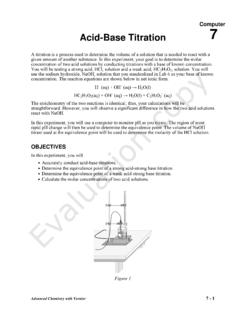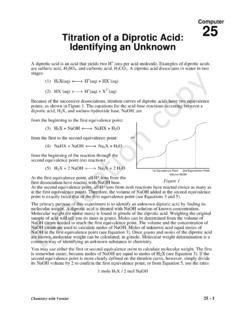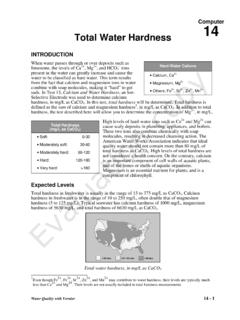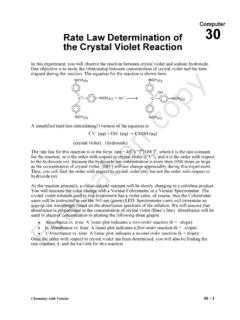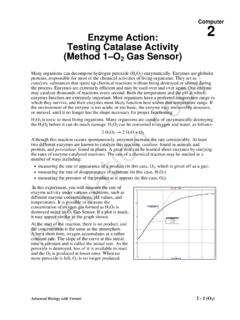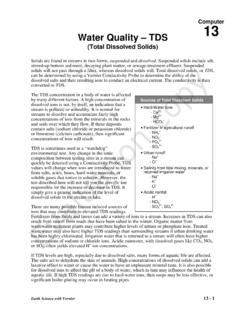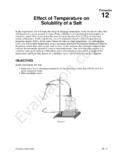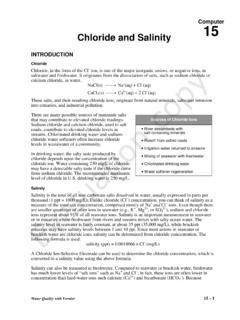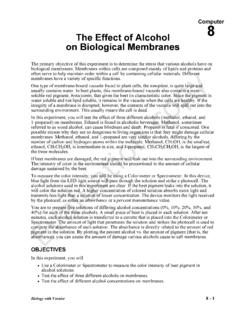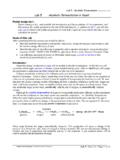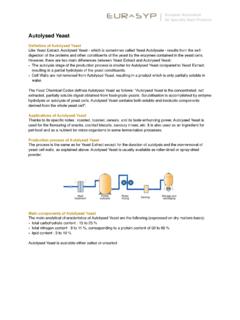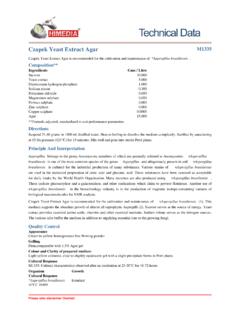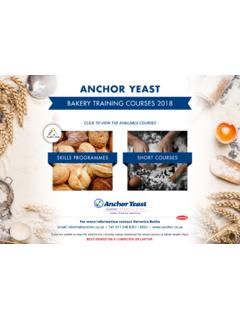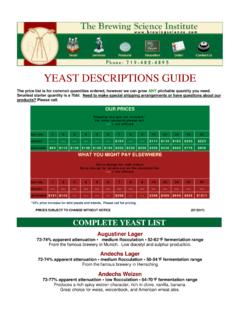Transcription of 12A Yeast Respiration CO2
1 Computer 12A Biology with Vernier 12A - 1 Respiration of Sugars by Yeast Yeast are able to metabolize some foods, but not others. In order for an organism to make use of a potential source of food, it must be capable of transporting the food into its cells. It must also have the proper enzymes capable of breaking the food s chemical bonds in a useful way.
2 Sugars are vital to all living organisms. Yeast are capable of using some, but not all sugars as a food source. Yeast can metabolize sugar in two ways, aerobically, with the aid of oxygen, or anaerobically, without oxygen. In this lab, you will try to determine whether Yeast are capable of metabolizing a variety of sugars. When Yeast respire aerobically, oxygen gas is consumed and carbon dioxide, CO2, is produced. You will use a CO2 Gas Sensor to monitor the production of carbon dioxide as Yeast respire using different sugars. The four sugars that will be tested are glucose (blood sugar), sucrose (table sugar), fructose (fruit sugar), and lactose (milk sugar).
3 OBJECTIVES In this experiment, you will Use a CO2 Gas Sensor to measure concentrations of carbon dioxide. Determine the rate of Respiration by Yeast while using different sugars. Determine which sugars can be used as a food source by Yeast . Figure 1 MATERIALS computer 600 mL beaker (for water bath) Vernier computer interface Beral pipettes Logger Pro hot and cold water Vernier CO2 Gas Sensor thermometer 250 mL Respiration chamber four 10 100 mm test tube 5% glucose, sucrose, lactose, and fructose sugar solutions Yeast suspension Evaluation copyComputer 12A 12A - 2 Biology with Vernier PROCEDURE 1.
4 Prepare a water bath for the Yeast . A water bath is simply a large beaker of water at a certain temperature. This ensures that the Yeast will remain at a constant and controlled temperature. To prepare the water bath, obtain some warm and cool water from your teacher. Combine the warm and cool water in the 600 mL beaker until it reaches 38 40 C. The beaker should be filled with about 300 400 mL water. Leave the thermometer in the water bath during the course of the experiment to monitor the temperature of the water bath. 2. Obtain five test tubes and label them G, S, F, L, and W. 3.
5 Obtain the four sugar solutions: glucose, sucrose, fructose, and lactose. a. Place 2 mL of the glucose solution in test tube G. b. Place 2 mL of the sucrose solution in test tube S. c. Place 2 mL of the fructose solution in test tube F. d. Place 2 mL of the lactose solution in test tube L. e. Place 2 mL of distilled water in test tube W. 4. Obtain the Yeast suspension. Gently swirl the Yeast suspension to mix the Yeast that settles to the bottom. Put 2 mL of Yeast into each of the five test tubes. Gently swirl each test tube to mix the Yeast into the solution. 5. Set the five test tubes into the water bath.
6 6. Incubate the test tubes for 10 minutes in the water bath. Keep the temperature of the water bath constant. If you need to add more hot or cold water, first remove as much water as you will add, or the beaker may overflow. Use a beral pipet to remove excess water. While the test tubes are incubating, proceed to Step 7. 7. If your sensor has a switch, set it to the Low (0 10,000 ppm) setting. Connect the CO2 Gas Sensor to the computer interface. Prepare the computer for data collection by opening the file 12A Yeast Respiration from the Biology with Vernier folder of Logger Pro.
7 8. When incubation is finished, use a beral pipet to place 1 mL of the solution in test tube G into the 250 mL Respiration chamber. Note the temperature of the water bath and record as the actual temperature in Table 1. 9. Quickly place the shaft of the CO2 Gas Sensor in the opening of the Respiration chamber. 10. Begin measuring carbon dioxide concentration by clicking . Data will be collected for 4 minutes. 11. When data collection has finished, remove the CO2 Gas Sensor from the Respiration chamber. Fill the Respiration chamber with water and then empty it. Make sure that all Yeast have been removed.
8 Thoroughly dry the inside of the chamber with a paper towel. Respiration of Sugars by Yeast Biology with Vernier 12A - 3 12. Determine the rate of Respiration : a. Move the mouse pointer to the point where the data values begin to increase. Hold down the left mouse button. Drag the pointer to the end of the data and release the mouse button. b. Click on the Linear Fit button, ,to perform a linear regression. A floating box will appear with the formula for a best fit line. c. Record the slope of the line, m, as the rate of Respiration in Table 1. d. Close the linear regression floating box.
9 E. Share your data with the class by recording the sugar type and Respiration rate on the board. 13. Move your data to a stored run. To do this, choose Store Latest Run from the Experiment menu. 14. Use a notebook or notepad to fan air across the openings in the probe shaft of the CO2 Gas Sensor for 1 minute. 15. Repeat Steps 8 14 for the other four test tubes. DATA Table 1 Sugar Tested Actual Temperature ( C) Respiration Rate (ppm/min) Glucose Sucrose Fructose Lactose Water (control) Table 2: Class Averages Sugar Tested Respiration Rate (ppm/min) Glucose Sucrose Fructose Lactose Water PROCESSING THE DATA 1.
10 When all other groups have posted their results on the board, calculate the average rate of Respiration for each solution tested. Record the average rate values in Table 2. Computer 12A 12A - 4 Biology with Vernier 2. On Page 2 of the experiment file, make a bar graph of rate of Respiration vs. sugar type. The rate values should be plotted on the y-axis, and the sugar type on the x-axis. Use the rate values from Table 2. QUESTIONS 1. Considering the results of this experiment, do Yeast equally utilize all sugars? Explain. 2. Hypothesize why some sugars were not metabolized while other sugars were.
